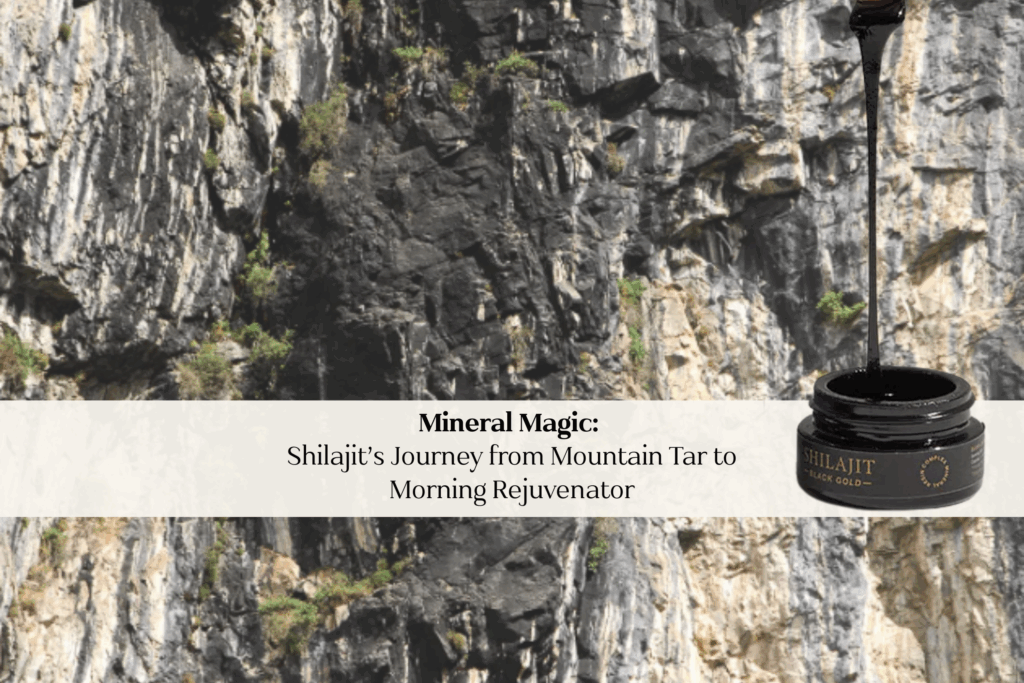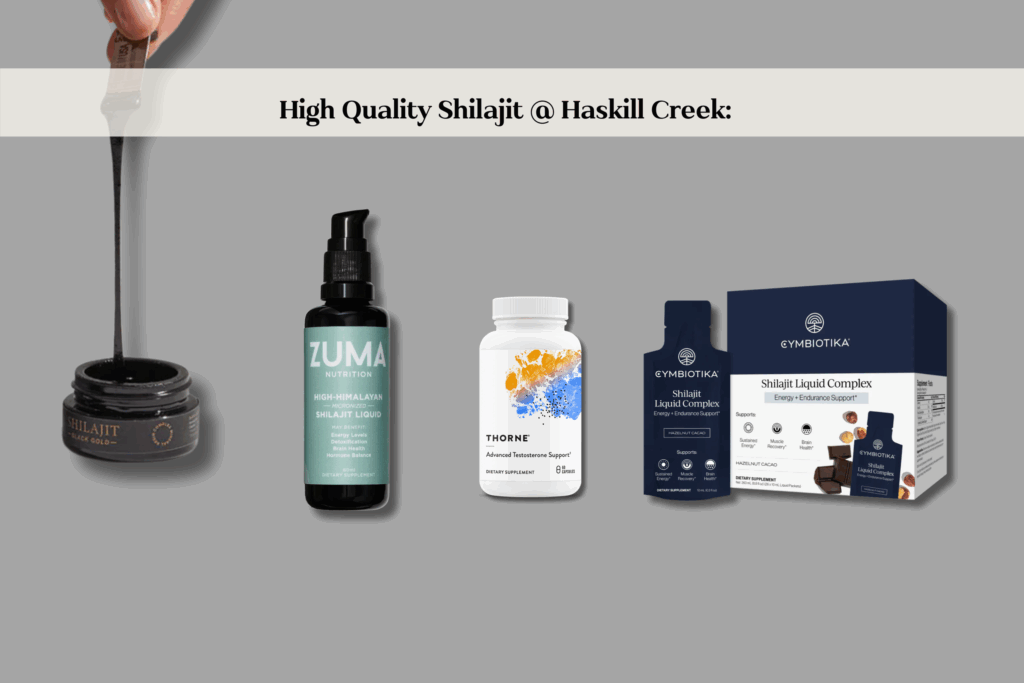Mineral Magic: Shilajit’s Journey from Mountain Tar to Morning Ritual

What’s black, sticky, and buzzing through the wellness world?
Shilajit (pronounced shee-lu-jeet) may sound like something out of a sci-fi novel, but this ancient tar-like substance that oozes from high mountain rocks has a legacy as bold as its appearance. In Sanskrit, its name means “conqueror of the mountains and destroyer of weakness”—a fitting title for a mineral-rich resin long prized in Ayurvedic medicine for its rejuvenating potential.
Now, modern wellness and biohacking circles are rediscovering Shilajit as a powerful daily ally for energy, vitality, and more.
But what exactly is it- and why is it suddenly everywhere?
What Even Is Shilajit?
Shilajit is a naturally occurring substance often described as a mineral pitch or resin, found in high-altitude mountain ranges like the Himalayas—typically between 1,000 and 5,000 meters above sea level. It forms slowly over centuries as organic matter like plants, fungi, and lichens decomposes and becomes compressed within layers of rock. Over time, this rich material seeps out of the earth, infused with a concentrated mix of minerals and bioactive compounds.1
The result? A sticky, tar-like substance that’s been revered for its vitality-enhancing properties for thousands of years.
What’s in It? A Quick Look at the Composition
Shilajit’s makeup is impressive: roughly 60%–80% organic material, 20%–40% minerals, and a small but potent dose of trace elements. Its star ingredients include fulvic acid, humic acid, and humin—compounds known for their ability to transport nutrients, support detoxification, and enhance cellular function.1
Fulvic acid, in particular, is a standout. It possesses natural antioxidant, immune-modulating, and anti-inflammatory properties, and is often credited as the powerhouse behind many of Shilajit’s benefits.2
On top of that, Shilajit has a natural electrolyte profile with more than 80 trace minerals, including essential nutrients like copper, iron, magnesium, selenium, and zinc—all of which support key biological processes throughout the body.3
Claimed Benefits: Ancient Promises Meets Modern Buzz
Traditionally used across Asia in Ayurvedic and folk medicine to treat a wide range of ailments, Shilajit has long been classified as a Rasayana– a category of rejuvenating substances believed to promote longevity, vitality, and resilience.2
Today, it’s gaining attention in modern wellness and research circles for its potential to support everything from energy and cognitive clarity to hormonal balance and cellular health.
Emerging studies suggest a growing list of benefits:
- Neuroprotective properties: Some research points to Shilajit’s potential in protecting against cognitive decline and neurodegenerative conditions like Alzheimer’s. 2
- Hormonal support: It’s often marketed for its ability to boost testosterone levels in men, which may contribute to increased stamina, vitality, and mood.4
- Bone & skin health: A small study found that Shilajit may help postmenopausal women improve bone density and even support collagen production. 5
- Fatigue-fighting effects: In both animal and human studies, Shilajit has been shown to enhance physical performance, reduce fatigue, and improve mitochondrial function—especially relevant in conditions like Chronic Fatigue Syndrome, which is increasingly understood as stemming from mitochondrial dysfunction.6
- At the cellular level, Shilajit has been shown to support ATP (adenosine triphosphate) production—the primary energy currency of the body.7
In short, Shilajit is being revisited not just as a traditional tonic, but as a revitalizer—one that may help the body adapt to modern-day stressors and energy demands.
Biohacking & Modern Appeal
You may have seen your favorite wellness influencer drizzling Shilajit into their morning coffee or stirring it into water to start the day. It’s gained traction in the biohacking world for its potential to boost energy, aid in athletic-recovery, sharpen focus, and support overall resilience.
Shilajit is available in several forms, but it’s most often found as a thick, tar-like resin, which many claim is the most authentic and potent version. Most brands recommend taking it first thing in the morning on an empty stomach for best results.
You’ll find it in capsule form, like in Thorne’s Advanced Testosterone Support, which features a trademarked extract known as PrimaVie®—a purified, clinical-grade form of Shilajit used in several published studies.
We also carry Cymbiotika’s Shilajit Black Gold Live Resin®, produced exclusively by Pürblack™—a brand known for meticulous sourcing and advanced resin processing. Cymbiotika also recently launched a Shilajit Superfood Liquid Complex with individual packets, making it more travel- and ritual-friendly.
For those who prefer a liquid tonic, Zuma Nutrition offers a micronized version designed for superior absorption, making it a great option for anyone looking to simplify their routine while maximizing bioavailability.

What to Look For (and Look Out For)
Sourcing is key—not just for nutrient quality, but for safety. Because Shilajit is harvested directly from rocky mountain crevices, contamination with heavy metals or mycotoxins is a real risk if proper purification steps aren’t followed. That’s why at Haskill Creek, we prioritize products with:
- Transparent sourcing
- Altitude/Location details
- Third-party testing for purity
Zuma Nutrition’s Shilajit, for example, is wild-harvested above 16,000 feet in the Indian Himalayas—an altitude known for producing some of the world’s purest resin. It’s thoroughly third-party tested to ensure both quality and safety—essential standards for any earth-derived supplement.
And the Shilajit resin we carry from Cymbiotika (produced by Pürblack) isn’t your average goo. It’s a 4th-generation hybrid resin created using a patented, science-backed process that preserves Shilajit’s complex natural chemistry while enhancing its safety and potency.
There are also a few health considerations to be aware of:
- Those who are pregnant or nursing, or individuals taking blood pressure medication, should avoid Shilajit unless directed by a healthcare provider.
- It’s also not recommended for those with sickle cell anemia, hemochromatosis, or thalassemia.
- Although rare, some users may experience side effects like rash, dizziness, or increased heart rate.8
As always, it’s best to consult a practitioner if you have preexisting conditions or are taking medications before starting a new supplement.
Final Takeaway
From ancient rejuvenator to modern-day morning ritual, Shilajit has carved out its place in the wellness world—with real, research-backed benefits. Whether it’s adding pep to your step or helping you bounce back from burnout, this mineral-rich resin is clearly here to stay. Just be sure you’re sourcing the real deal: pure, potent, and responsibly harvested—from the heart of the mountains to your favorite morning brew.

Sign up for our newsletter!
Join to get the Haskill Newsletter and be the first to learn about new products, events, and other goings-on at Haskill Creek!









